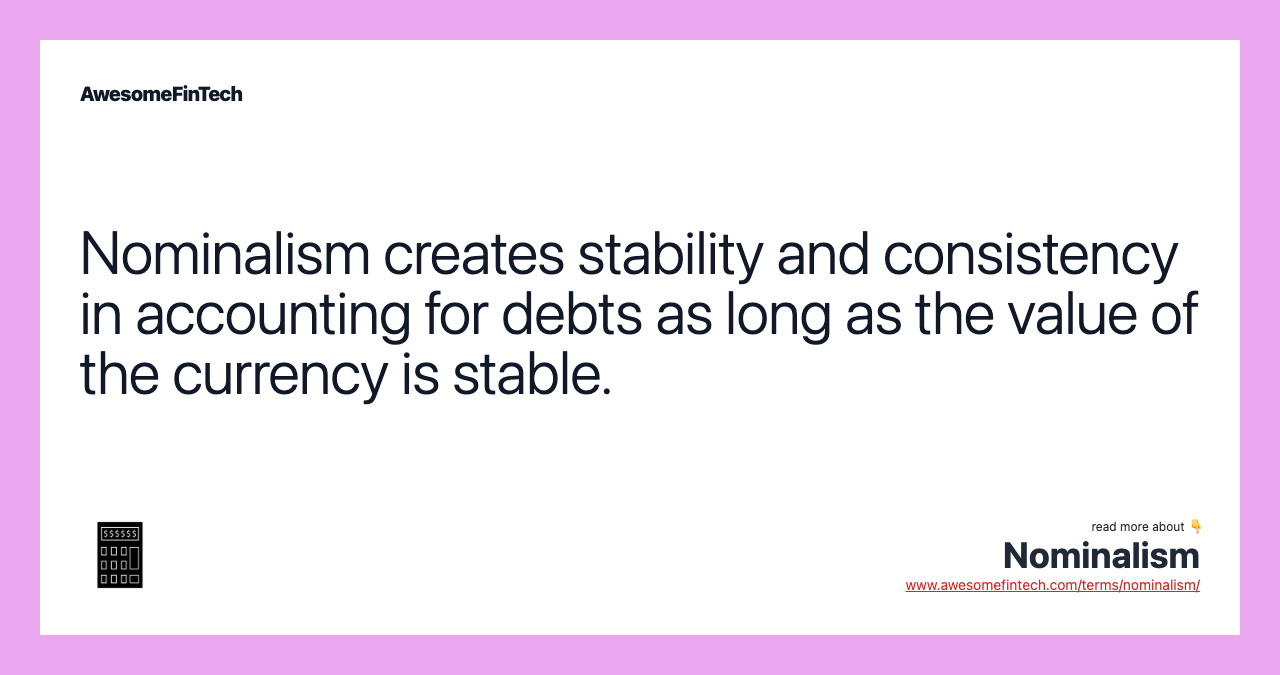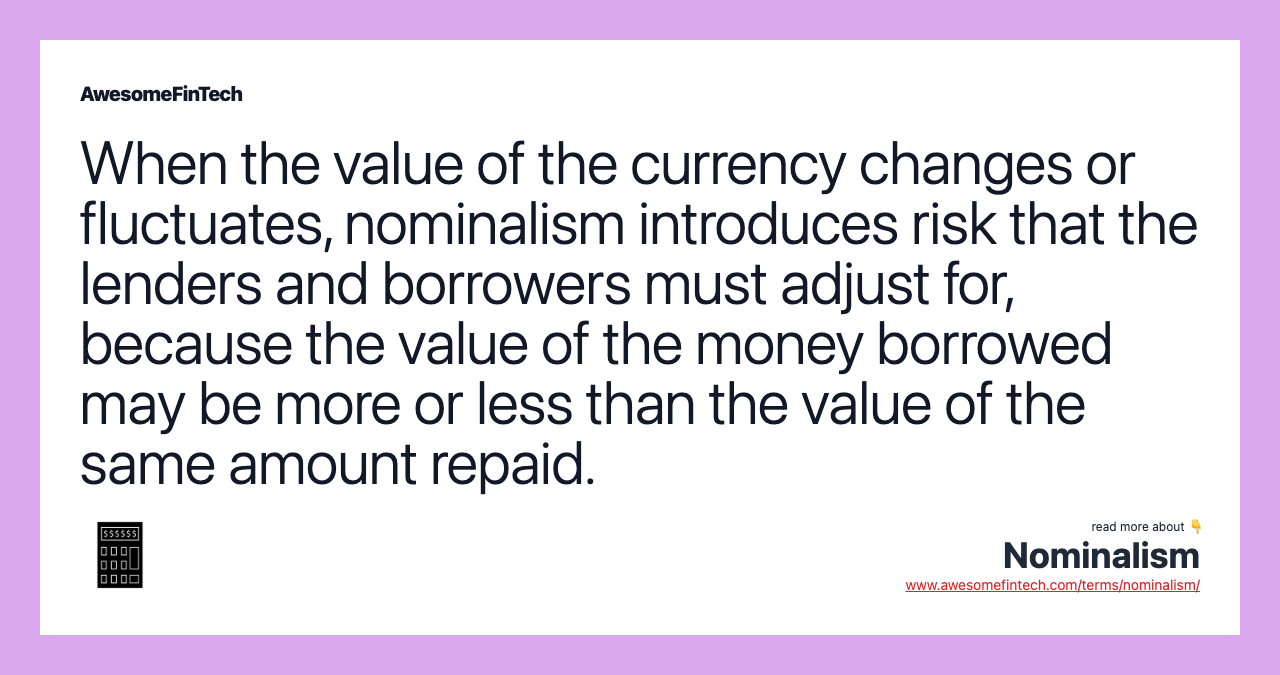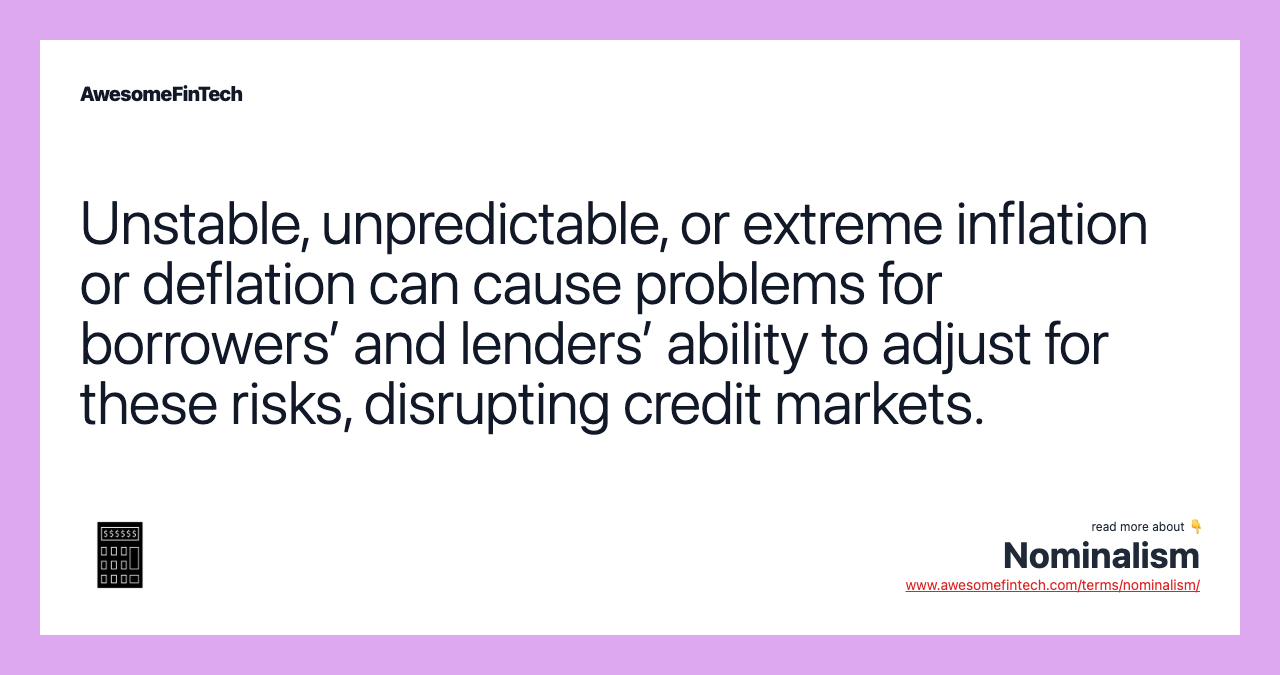Nominalism
Nominalism is the concept that the dollar amount of a loan remains fixed on financial statements, despite fluctuations in inflation or exchange rates which may affect the actual purchasing power of the money. During period of consistent inflation, when the currency loses value at a stable rate, lenders can relatively easily adjust for the loss of purchasing power by charging an inflation premium added on to the interest rate they demand for a loan. When the value of the currency changes or fluctuates, nominalism introduces risk that the lenders and borrowers must adjust for, because the value of the money borrowed may be more or less than the value of the same amount repaid. Nominalism keeps the dollar amount of an asset or liability, including debt obligations, fixed in terms of the monetary unit regardless of changes to the purchasing power of money, subject only to changes in the actual value of the asset or liability itself. Unstable, unpredictable, or extreme inflation or deflation can cause problems for borrowers’ and lenders’ ability to adjust for these risks, disrupting credit markets. Nominalism falls under the Generally Accepted Accounting Principles (GAAP) as part of the Monetary Unit assumption, that all accounts and transactions be recorded in a quantifiable, stable monetary unit.

More in Economy
What is Nominalism?
Nominalism is the concept that the dollar amount of a loan remains fixed on financial statements, despite fluctuations in inflation or exchange rates which may affect the actual purchasing power of the money. Nominalism puts the risk of inflation or depreciation of the currency on the creditor and the risk of deflation or appreciation of the currency on the debtor.




Understanding Nominalism
Nominalism falls under the Generally Accepted Accounting Principles (GAAP) as part of the Monetary Unit assumption, that all accounts and transactions be recorded in a quantifiable, stable monetary unit. In the U.S. the Financial Accounting Standards Board (FASB) defines the nominal value of the U.S. dollar (unadjusted for inflation) as the standard monetary unit of record under GAAP.
Nominalism keeps the dollar amount of an asset or liability, including debt obligations, fixed in terms of the monetary unit regardless of changes to the purchasing power of money, subject only to changes in the actual value of the asset or liability itself. Nominalism is a legal principle that states the dollar amount of a loan must remain a fixed figure on the balance sheet. It does not fluctuate with the rate of inflation or currency exchange rate.
Nominalism creates consistency in accounts and transactions over time, by valuing all transactions in a stable unit of account, as opposed to trying to adjust each transaction and constantly revalue assets and liabilities for purchasing power. In a stable monetary environment, where the value of the currency does not change greatly, the nominal and real value of the currency are identical anyway. However, risks and difficulties can arise when the value of the currency fluctuates relative to other goods or other currencies. Large or persistent change in the value of the currency can ultimately undermine money's function as a unit of account entirely, as happens in the case of hyperinflation.
Changes in money’s value can place a certain amount of risk on the lender because as inflation rises, the purchasing power of money erodes. When the purchasing power of money erodes, it makes the real value of the repayments of the loan less. Lender’s normally account for this risk by charging a higher interest rate on the loan. Essentially, in an inflationary environment, a lender receives less money back in the form of principal repayment than they would with a stable currency.
On the other hand, during periods of deflation, this risk is suffered by the borrower who must repay the debt in units of currency that are more valuable than what they borrowed. For a business that borrows to finance operations, deflation often puts borrowers in double danger. Because prices have fallen, this may mean that they must lower the price of their output on the market, while the dollar amount of their debt remains fixed. So they may have less revenue coming in, while facing the same loan payments as before the deflation.
Example of Nominalism
XYZ Company, a company located in Morovia, borrowed $1,000,000 on January 1. Inflation occurs in Morovia during the following 12 months. The purchasing power of the dollar falls so much that six months later on July 1, the $1,000,000 that was borrowed on January 1 will now only purchase about half of what it did at the beginning of the year. The value of the $1,000,000 has dropped by 50%. This is bad news for the lender to XYZ Company because their scheduled principal repayments are now also worth only half of what they would've been without the current rate of inflation. However, because of nominalism, the dollar amount of the loan stays fixed at $1,000,000 despite the fluctuations in the real value of the currency.
Special Considerations
During period of consistent inflation, when the currency loses value at a stable rate, lenders can relatively easily adjust for the loss of purchasing power by charging an inflation premium added on to the interest rate they demand for a loan. For example, if the lender demands 3% interest for forgoing the use of their money and expects inflation to increase prices by 5%, then they can charge 8% for the loan to adjust for inflation. This is normal practice and can adjust for any expected inflation.
However, lenders may have a harder time adjusting when inflation is not stable and predictable or when deflation occurs. When inflation is unpredictable, the lender must adjust not only for for higher future prices, but also for the fact that they can’t reliably predict how fast prices will rise. Unstable inflation rates can thus result in very high market interest rates.
In the second case, deflation, while a lender can to some extent charge a lower interest rate to adjust for the increased purchasing power of money, market interest rates are generally constrained by a lower bound at 0%. An interest rate less than 0% would mean the lender is actually paying the borrower to take a loan, and the lender would obviously be better off simply holding on to the cash rather than making a loan at a loss.
In either the case of unstable inflation, rapid deflation, or the previously mentioned hyperinflation, credit market participants inability to adjust for changes in the purchasing power of sums lent and borrowed, can produce widespread disruption of credit markets. This is routinely seen during events such as sharp recessions or hyperinflationary episodes.
Related terms:
Economics : Overview, Types, & Indicators
Economics is a branch of social science focused on the production, distribution, and consumption of goods and services. read more
Financial Accounting Standards Board (FASB)
The Financial Accounting Standards Board (FASB) is an independent organization that sets accounting standards for companies and nonprofits in the United States. read more
Generally Accepted Accounting Principles (GAAP)
GAAP is a common set of generally accepted accounting principles, standards, and procedures that public companies in the U.S. must follow when they compile their financial statements. read more
Hyperdeflation
Hyperdeflation is an extremely large and relatively quick level of deflation in an economy. read more
Hyperinflation
Hyperinflation describes rapid and out-of-control price increases in an economy. In this article, we explore the causes and impact of hyperinflation. read more
Inflation-Indexed Security
An inflation-indexed security is a security that guarantees a return higher than the rate of inflation if it is held to maturity. Inflation-indexed securities link their capital appreciation, or coupon payments, to inflation rates. read more
Inflation
Inflation is a decrease in the purchasing power of money, reflected in a general increase in the prices of goods and services in an economy. read more
Inflationary Risk
Inflationary risk is the risk that unanticipated inflation will reduce the value of an asset or income stream. read more
Purchasing Power
Purchasing power is the value of a currency in terms of the goods or services one unit of it can buy. Discover how purchasing power impacts investors. read more